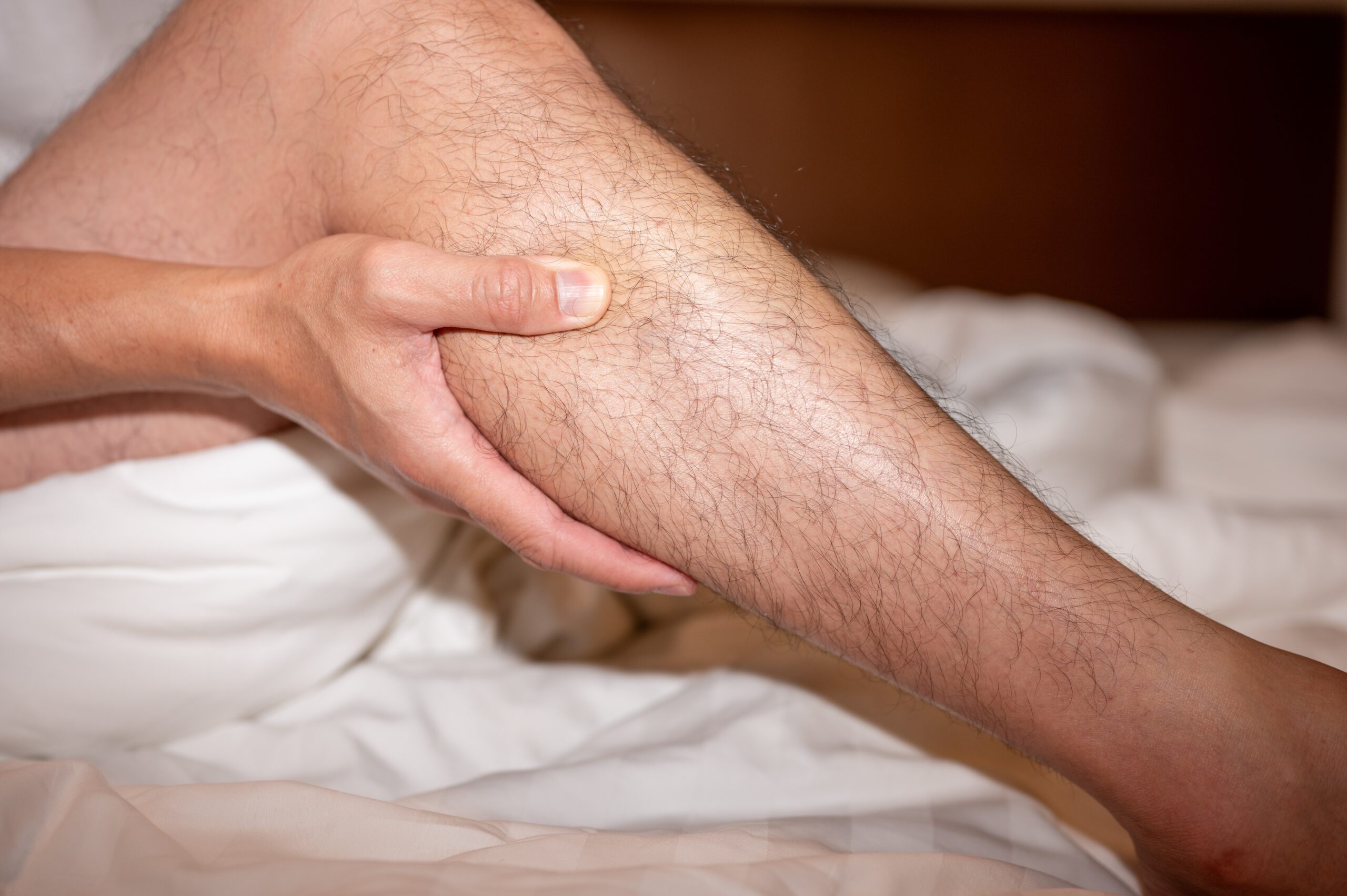Leg muscle cramps can strike suddenly, causing sudden pain that stops you in your tracks. Whether they happen during exercise, while you’re sitting, or in the middle of the night, these involuntary muscle contractions can be painful and unsettling.
Leg cramps often have different causes. Learning what’s behind them can make it easier to manage the pain and prevent it from coming back.
In this guide, you’ll learn what causes leg muscle cramps, how to treat them at home, when to seek medical help, and how to prevent them in the future.
What Are Leg Muscle Cramps?
Leg muscle cramps are sudden, involuntary contractions of one or more muscles in the leg. They often cause sharp pain and tightness, making it hard to move the affected area until the cramp releases.
Most cramps happen in the calf muscles, but they can also affect the thighs, feet, or even the hamstrings. Some people experience a thigh cramp that can leave lingering soreness for hours.
Cramps can happen during activity, at rest, or while sleeping. They’re especially common at night, and nocturnal leg cramps can disrupt sleep if they occur frequently.
Even though leg muscle cramps are usually harmless, they can be uncomfortable and sometimes point to an underlying condition that needs attention.
What Causes Leg Muscle Cramps?
Below are some of the most common causes of leg muscle cramps:
Dehydration and Electrolyte Imbalance
When your body loses too much fluid or key minerals like potassium, calcium, or magnesium, your muscles may cramp more easily. Even mild dehydration can make muscles more sensitive and prone to tightening, especially if plenty of fluids are neglected.
Overuse of Muscles During Exercise
Pushing your muscles too hard during playing sports or intense workouts can lead to cramping, especially if you skip warming up or cooling down. Repeated stress on tired muscles increases the chances of a muscle spasm developing.
Prolonged Sitting, Standing, or Sleeping Positions
Holding the same position for a long time can limit blood flow and strain muscles, leading to cramps. Sitting for hours with poor posture can make muscles more vulnerable to spasms.
Poor Blood Circulation
When blood vessels in the legs are restricted, muscles may not get enough blood and oxygen to function properly. Circulation problems can lead to frequent or severe cramps, especially during rest.
Nerve Compression and Spinal Issues
Pressure on nerves in the lower back or legs can trigger cramping. Conditions like spinal stenosis or a herniated disc can cause nerve damage, leading to tightness or pain that feels like muscle cramps.
If you notice cramping along with numbness, tingling, or muscle weakness, it’s important to discuss these other symptoms with a healthcare provider.
Pregnancy-Related Leg Muscle Cramps
During pregnancy, extra weight and changes in circulation put more strain on the legs, especially at night. Hormonal shifts can also affect muscle function, increasing the risk of leg cramps at night.
Gentle stretching, hydration, and keeping blankets loose at the foot of the bed often help lessen cramping during pregnancy.
Medication Side Effects That Trigger Cramps
Some medications, like diuretics used for high blood pressure, statins, or certain asthma drugs, may increase the risk of muscle cramps. These medications can affect fluid balance or muscle sensitivity.
If you think a prescription might be contributing to cramping, bring it up with your doctor. Never stop or adjust medication without professional guidance.
Underlying Medical Conditions
Certain health conditions, including diabetes, kidney failure, thyroid disorders, liver disease, and peripheral artery disease, can make muscle cramps more likely. These conditions may interfere with how nerves and muscles communicate, leading to more frequent cramping episodes.
Symptoms and Signs of Leg Muscle Cramps
A leg muscle cramp usually feels like a charley horse—a sudden, sharp tightening of the muscle. It can happen without warning and often makes it hard to move or put weight on the affected leg.
While cramps are usually harmless, paying attention to how they feel and how often they occur can help you decide if further care is needed.
How to Identify a Leg Muscle Cramp
- Sharp, intense pain: The pain usually starts suddenly and feels like the muscle is knotting up.
- Visible muscle tightening: The muscle may look hard, raised, or twisted under the skin.
- Temporary difficulty moving: It can be hard to straighten or flex the leg while the cramp is happening. Applying light pressure to a cramped muscle often helps it relax.
Most muscle cramps go away within a few minutes, but most muscle cramps still leave the muscle feeling sore afterward.
How Long Do Leg Muscle Cramps Typically Last?
Most cramps last from a few seconds to about ten minutes. The calf muscles are the most common place for a cramp to occur, but the legs and feet are both frequently affected.
Even when a cramp is brief, it can leave behind soreness or tightness that lingers, especially if the muscle was heavily strained.
When to Be Concerned About Frequent Cramps
Occasional cramps are usually nothing to worry about. However, it’s a good idea to talk with a doctor if:
- Cramps happen frequently or severely
- Muscle cramps occur along with leg swelling, numbness, or noticeable skin changes
- The cramping interferes with sleep, daily activities, or exercise
Persistent cramps can sometimes signal a more serious health condition that deserves closer attention.
How to Prevent Leg Muscle Cramps
When a leg cramp strikes, finding fast relief becomes the immediate goal. Fortunately, there are simple steps you can take at home to ease the pain and help the muscle relax.
Stretching and Flexibility Exercises
Gentle stretching before and after exercise keeps muscles flexible and less prone to sudden tightening. Focus especially on the calves, hamstrings, and thighs to help prevent leg cramps.
Staying Properly Hydrated
Drinking plenty of water throughout the day supports healthy muscle function. During hot weather, exercise, or periods of heavy sweating, increasing fluid intake can help replace what the body loses.
If dehydration is a concern, electrolyte-rich drinks or foods like coconut water, leafy greens, and bananas can help maintain mineral balance.
Nutrition Tips to Support Muscle Health
Muscles rely on minerals like potassium, magnesium, and calcium to work properly. Including foods rich in these nutrients can support muscle relaxation.
Adding foods rich in vitamin B may also promote better muscle health over time.
Exercise and Warm-Up Routines
Gradually increasing the intensity of exercise gives muscles time to adjust and grow stronger. Warming up before activity and cooling down afterward can help ease muscle tension and reduce the chances of cramping or pain.
Wearing Proper Footwear
Supportive shoes help protect leg muscles during walking, standing, or exercise. Shoes that fit well and provide enough cushioning can improve balance and circulation, which are important for muscle health.
Replacing worn-out or unsupportive footwear may also reduce strain on the legs.
Adjusting Sleep Positions to Avoid Leg Cramps at Night
Sleeping with toes pointed downward can tighten the calves. Keeping your feet slightly flexed or placing a pillow under your knees can help reduce cramping at night.
If a cramp occurs during sleep, it often helps to gently rub the muscle and apply heat to help it release. Soaking in a warm bath before bed or using an ice pack after exercise can also help muscles stay relaxed.
Who Is Most at Risk for Leg Muscle Cramps?
While leg muscle cramps can affect anyone, certain risk factors make them more likely. Athletes, older adults, pregnant individuals, and people managing chronic conditions face a higher risk.
Athletes and people who exercise frequently may be more vulnerable because of muscle overuse, dehydration, or mineral loss through sweat. Older adults are also more likely to have cramps due to natural changes in muscle tone and circulation with age.
Pregnant individuals often deal with nighttime leg cramps as weight, fluid balance, and circulation shift during pregnancy.
Certain chronic conditions like diabetes, kidney disease, thyroid disorders, and nerve problems can increase the chances of cramping, too.
When Should You See a Doctor About Leg Muscle Cramps?
Most leg muscle cramps go away on their own and don’t cause long-term problems. But sometimes, frequent or severe cramps can be a sign that something else needs attention.
It’s a good idea to talk with a doctor if leg cramps happen often, wake you up regularly, or interfere with daily activities. Cramping that comes with swelling, numbness, changes in skin color, leg swelling, or weakness also deserves a closer look.
During a medical evaluation, the doctor will ask about your symptoms, medical history, and any medications you’re taking. In severe cases, they may recommend blood tests, circulation studies, or imaging to find the cause of the cramps.
If needed, they might also discuss options like muscle relaxants to help control cramping while addressing the underlying issue.
Early evaluation can help catch underlying conditions before they lead to bigger health issues.
Wellness and Pain Offers Solutions for Lasting Leg Cramp Relief
Leg muscle cramps can disrupt sleep, limit activity, and cause unnecessary discomfort. Addressing the underlying cause with expert care often leads to stronger, more flexible muscles and fewer painful leg cramps.
Wellness and Pain provides comprehensive services to diagnose, treat, and prevent leg muscle cramps. Our specialists identify whether cramps stem from circulation issues, muscle strain, nerve damage, or other health concerns, then create a treatment plan for effective relief.
Schedule a consultation with Wellness and Pain today. We’ll find solutions that support better movement, greater comfort, and long-term muscle health.
FAQs About Leg Muscle Cramps
How can I stop cramps in my legs?
When a cramp starts, gently stretch and flex the affected muscle. For example, if your calf cramps, straighten your leg and pull your toes toward your buttocks while keeping the leg extended. Massaging the area and applying a warm towel or heating pad can also help the muscle relax more quickly.
If cramps happen often, daily stretching, staying hydrated, and maintaining good nutrition can lower the chances of future episodes.
What drink stops leg cramps?
Water is the best choice to keep muscles hydrated and reduce cramping. Drinks rich in electrolytes, like coconut water or an electrolyte solution, can help if mineral loss is part of the problem. It’s important to replace lost fluids, especially after exercise or sweating, and focus on treating muscle cramps early when signs appear.
What deficiency causes leg cramps?
Low levels of minerals like magnesium, potassium, or calcium can make muscles more prone to cramping. Dehydration can also worsen these imbalances.
If you suspect a deficiency, your doctor may recommend a blood test to check your levels and suggest dietary changes or supplements if needed.
What is the main cause of leg cramps?
Leg cramps often result from a combination of factors, including muscle fatigue, dehydration, and mineral imbalances. Other triggers can include poor circulation, nerve irritation, or side effects from certain medications. Some cramps also occur without a known reason.











